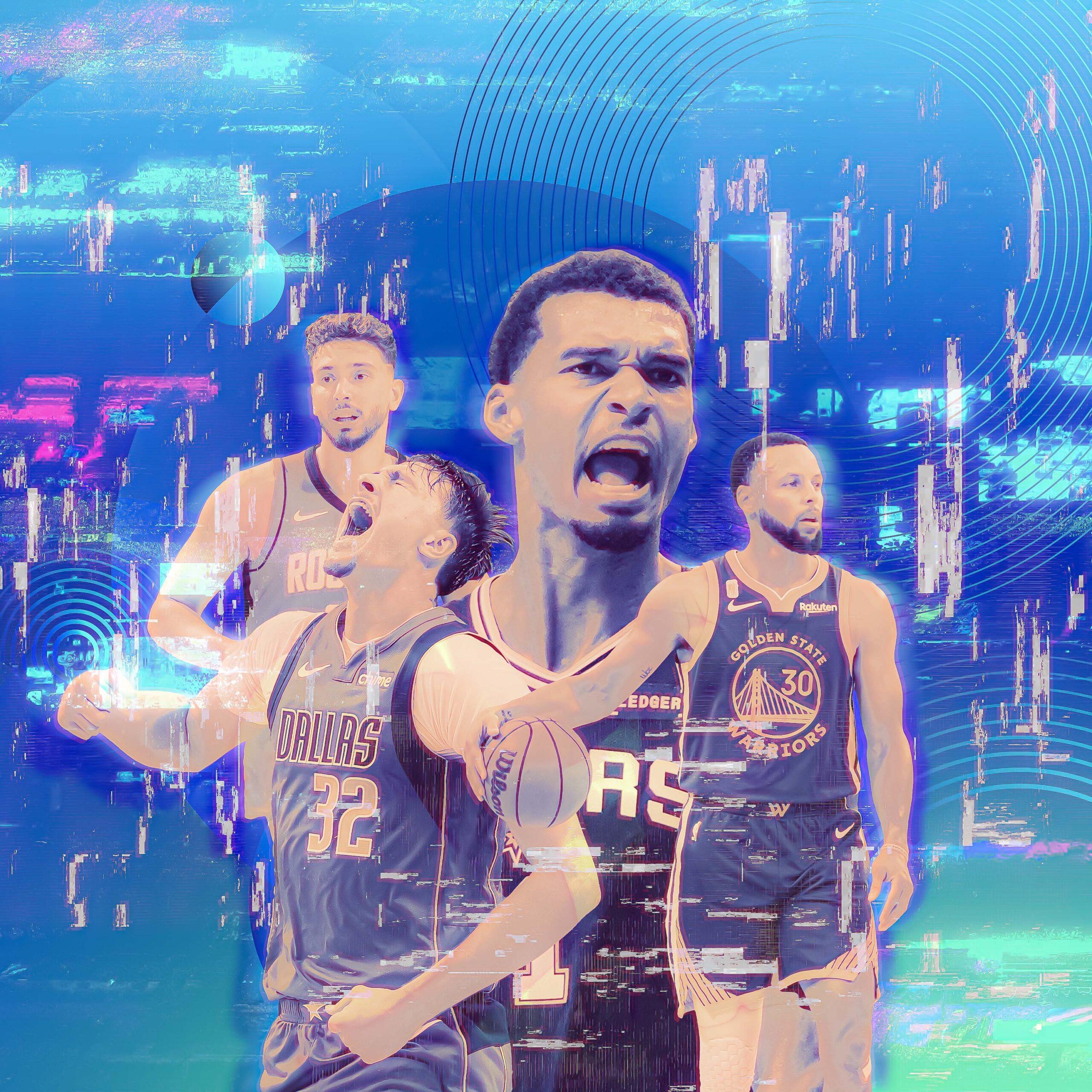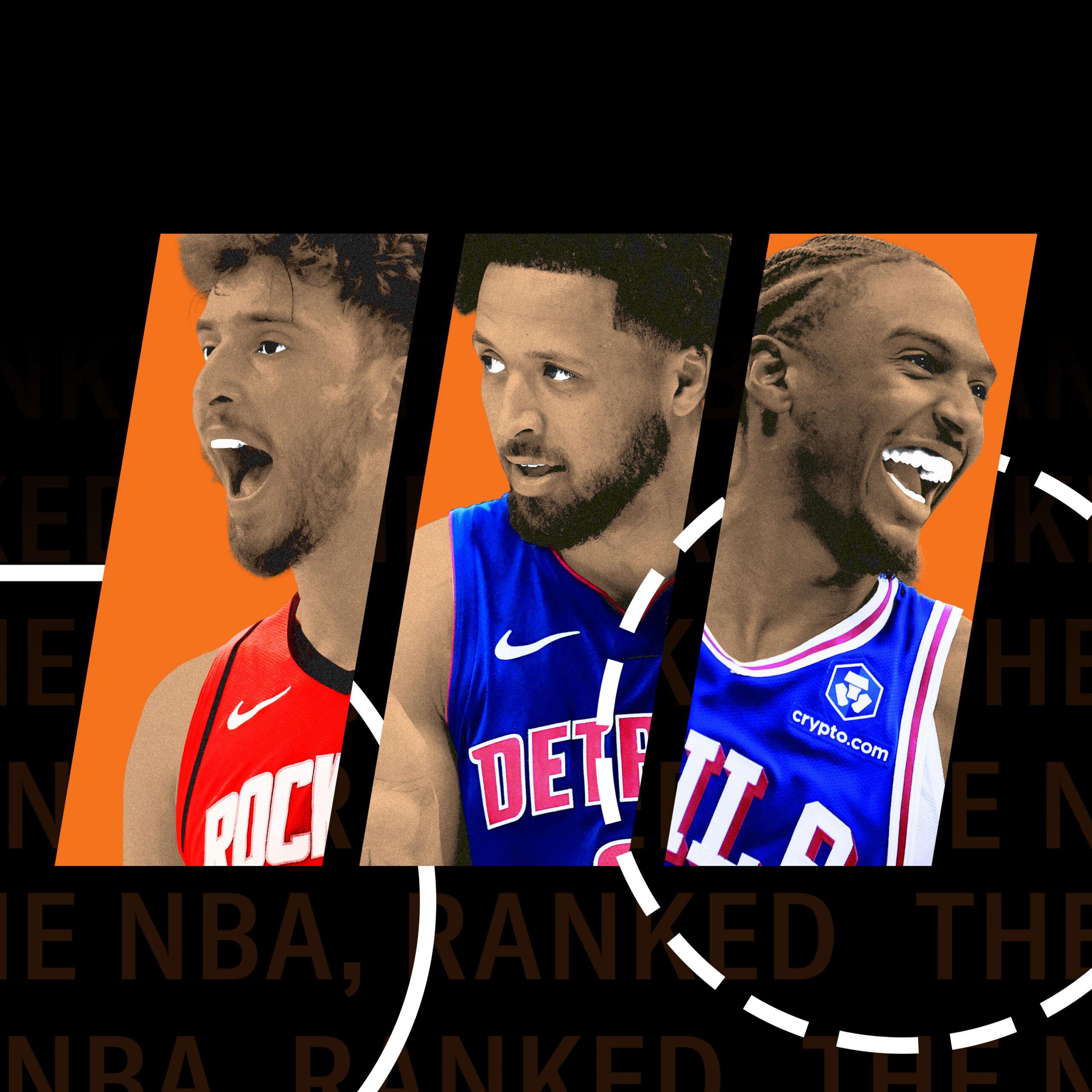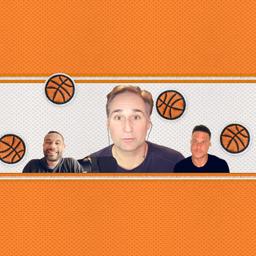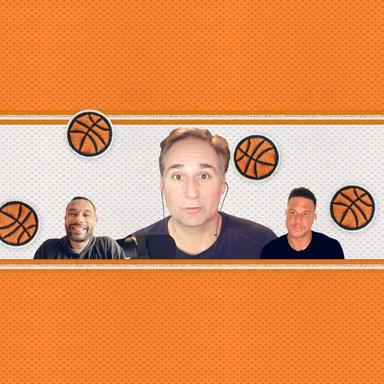
We’re nearly one week into the 2025-26 NBA season, and basketball is sweating from my pores. The games have been phenomenal. The seismic news that nearly overshadowed all of them is a drag. But in this column, we’ll focus on everything that’s happened on the court, with 13 overreactions about players, teams, and trends in a season that has even more questions today than it did when it tipped off. Let’s dive in.
1. Golden State is a Tier 1 contender.
To be in this category, you need to have slightly more than a puncher’s chance of beating the Thunder or Nuggets in a playoff series; a “been there, done that” degree of self-belief; A-plus star power; depth; 3-point shooting; and a roster that can adapt on the fly against different opponents during a playoff run. The Warriors check all those boxes!
Now, what the Warriors don’t have is Father Time’s blessing. Steph Curry, Jimmy Butler, Al Horford, and Draymond Green are all perpetual injury risks on the wrong side of 35. No small thing. But that shortcoming isn’t enough to disqualify them in October. In its first couple of games, Golden State’s offense was seamless. The Warriors tortured the Lakers and Nuggets by cramming them into a blender of cuts and screens and 3s. Curry looked like Curry. Horford provided some pop and steadiness at the 5 that they haven’t had in recent years. And, after months of foreboding contract drama that spelled a seemingly inevitable end to his tenure with the Warriors, Jonathan Kuminga might be evolving in some extremely helpful ways.
There’s a thin line between record-scratching a possession and being patient with the ball in your hands. Kuminga might have finally grasped the difference between the two.
Is there a universe where Kuminga makes nice with the Warriors, unveils a more potent outside shot, buys into the confines of a supplementary role, and refrains from hijacking possessions with poor decisions? I didn’t think so before the season, but so far Kuminga is making genuine winning plays that don’t show up in the box score. Take this sequence as an example: Defending a stack pick-and-roll against Los Angeles, he sticks his ass out and bumps Deandre Ayton off his line, turning an alley-oop into an interception.
And here he is mucking up another one of Ayton’s rolls, then going down into the paint and tipping the rebound to a teammate.
This stuff adds up. It’s smart, infectious, and symptomatic of how good habits can turn contenders into champions. Eight months from now, that may just be what the Warriors are.
2. The Victor Wembanyama era is here.
It’s hard to, um, overreact here. Watching Wembanyama’s unreasonably dominant showing in Dallas made me feel like the San Antonio Spurs can win the title this season. I already thought Victor would eventually take the “best player alive” label from Nikola Jokic, but the timeline for when that happens might be fast-tracked.
Wemby made Anthony Davis (Anthony freaking Davis!) look like a child and then followed it up with two breathtaking performances against New Orleans and Brooklyn. His handle, touch, power, footwork, and body control are considerably improved from last year. He’s using the 3-point shot more as a threat than a concession, driving to the basket and forcing defenders to play a step closer to him than they’d prefer.
When you combine all of the ways he makes life easier for teammates on offense, reading the floor and scoring at will, it’s almost easy to overlook the fact that we’re talking about the best defender in the league and someone who may retire as the most intimidating presence in basketball history. Look at this shit:
Lol:
This is a game plan–melting individual who may win MVP, DPOY, and Most Improved Player this season. A scoring title is possible. Statistical records will be shattered. Until further notice, Wemby’s transformation into a bona fide top-five player is the most important development in the NBA.
3. The NBA might enforce 10-second violations this year!
Giannis Antetokounmpo is off to an incredible start and unsurprisingly looks like an MVP candidate. He also takes at least 10 seconds to shoot a free throw a few times every game. This is against the rules but almost always gets ignored by the officials. But in the second quarter of Milwaukee’s season-opening romp over Washington, Giannis was actually punished for it. This is progress!
4. Alperen Sengun is an MVP candidate.
Here’s the case: Houston finishes as a top-three seed in the Western Conference. Sengun is its best player, and he spends an inordinate amount of time at point guard, leading the Rockets in touches and dramatically increasing his volume and accuracy from behind the 3-point line. Meanwhile, he’s a key cog in an elite defense, which Sengun already spent last season proving he can be.
This seemed plausible after opening night, when Sengun finished with 39 points, 11 rebounds, and seven assists while going 5-for-8 from deep. With last year’s top two ball handlers—Fred VanVleet and Jalen Green—no longer around, there were significant opportunities for Sengun to make plays in a Houston offense that may need to mold itself around his unique skill set. (Sengun generated only 1.5 free throw attempts from the 7.7 drives per game he averaged last year. In Houston’s season opener, he logged eight free throws from his 18 drives. Encouraging!) Sengun should be able to run pick-and-rolls, operate from the mid-post, and leverage his back-to-the-basket power against defenses that aren’t super pumped to double him while Kevin Durant, Jabari Smith Jr., Amen Thompson, and Reed Sheppard are on the floor.
Unfortunately, Friday night against the Pistons was a different story. Sengun finished 5-for-18 from the field and badly missed both his 3s. A majority of his drives went nowhere, and, despite finishing with seven assists, Sengun forced too much of the action in desperate attempts to draw fouls that weren’t being called. If he can find a sweet spot in between that disaster and his masterpiece against OKC while leading Houston in usage rate and buoying a decent half-court offense, Sengun may actually hear his name pop up in debates about this season’s MVP.
5. Utah’s Big Three is the future of basketball.
Consider me all in on the Lauri Markkanen, Walker Kessler, Kyle Filipowski three-headed monster that’s taking the NBA by storm. They’re plus-21 in 27 minutes! Even if the Jazz lose 75 percent of their games this season, any team that can fit that much size, skill, and mobility on the court at once is doing something right.
6. Jalen Johnson is (by far?) Atlanta’s best player.
There are dozens of players in today’s NBA who are more accomplished than Johnson. But only a few of them can casually make the most arduous parts of basketball look easy. People that large, with this hang time, who can see the floor and instantly process everything that’s happening, are basketball gemstones. Most jump passes are, at best, not advised and, at worst, the reason a head coach just called a timeout to sub you out of the game. But Johnson’s are both gorgeous …
… and useful.
Could he lead the Eastern Conference in triple-doubles this season? Maybe! If Johnson can find a more stable way to dominate games in the half court, consider his first All-Star appearance a lock.
7. Minnesota’s crunch-time woes are over.
I covered this in my increasingly bold predictions season preview piece, but the next step Anthony Edwards needs to take if he wants to win MVP trophies and scoring titles is to consistently dominate close games and carry the Timberwolves to victory. Last year, Minnesota ranked 20th in crunch-time offense. Edwards’s struggles were one reason why. He led the league in clutch points but did so shooting 32.3 percent from deep and 42.6 percent from the floor. He also recorded 13 assists and 15 turnovers in those 160 minutes. Ugly stuff.
That doesn’t mean Minnesota’s fourth-quarter attack was a mud puddle when the ball rested in Ant’s hands, but there’s significant room for improvement, whether that means honing his midrange jumper or making quicker decisions in the face of a double-team. Single-handedly snuffing out the Blazers on opening night was a solid start.
8. The Sixers are in heaven and hell.
Daryl Morey didn’t set out to straddle two polar-opposite timelines when he came to Philadelphia. But here the Sixers are—blessed and doomed, living their best and worst life.
Philly might already have one of the most thrilling backcourts in the league. Rookie VJ Edgecombe and (actual franchise player) Tyrese Maxey set the Boston Celtics on fire Wednesday night with an exhilarating and highly efficient 74 combined points. It was only one game (both players cooled down a bit in a close win against Charlotte a couple of nights later). But sometimes the future becomes the present much faster than anyone expected.
Speaking of fast: On the first dunk of his career, Edgecombe caught a pass behind the 3-point line, took one dribble, and exploded through Boston’s rotating half-court defense. Poor Xavier Tillman didn’t even enter the rookie’s peripheral vision. Speed kills.
Edgecombe will be up and down, as most rookie guards are, but so long as he’s on the court with Maxey—who may become the best point guard in the Eastern Conference this season—there will always be an opportunity to crack into a defense that’s in scramble mode. Maxey is impossible to keep at bay and a constant threat to score from the moment he crosses half court. No stepback is prettier. Toss in Jared McCain off the bench when he gets back from a thumb injury, and there will be no rest trying to slow Philadelphia’s guards down.
The flip side of all this optimism is simple: Joel Embiid seemingly can’t run or jump and is guaranteed $243.4 million through 2029. Right now, he’s a part-time player who isn’t able or willing to play defense more than a few feet away from the basket. On offense, he’s stationary. According to Sportradar, Embiid has popped 55 percent of the time after setting a ball screen this season. In 2023, that number was 27 percent. Look at his effort getting back in transition on this play.
And then we have problem no. 2: Paul George is 35 years old, currently hurt, and owed $162.3 million through 2028. I don’t really have anything specific to overreact to here, but the juxtaposition between young, athletic, and invigorating and rickety, dwindling, and expensive is just so jarring. Philly’s universe contains both realities. It’s a complicated way to go through a season, and if you’re a Sixers fan who wants to bifurcate the situation, it’s the ultimate eye-of-the-beholder conundrum. Your glass is either half full or bone dry. There’s either a light at the end of this tunnel or we’re not even halfway through a crisis that feels like it’ll never end.
9. Dallas is not doing Cooper Flagg any favors.
It’s only Flagg’s rookie season, and even though he’s aced every developmental challenge in his basketball career, we still don’t know exactly what his capacity will be to overcome the on-court obstacles embedded in his current situation. Typically, a growing franchise player can’t become the best version of himself without a franchise that builds around what he can and can’t do.
That isn’t happening in Dallas right now. Flagg is playing point guard, which is fine. It makes sense to put the ball in his hands under the tutelage of a brilliant former point guard. But trying this approach on a team that’s pot committed to a pair of big men who can’t space the floor is not fine. In his debut, Flagg spent only the first few minutes of the first and third quarters next to both Anthony Davis and Dereck Lively II, but the cramped floor did not make his life as easy as it could be:
His debut was a zero-assist, three-turnover dud that garnered a Least Valuable Player badge from ESPN analytics; Flagg had –8.1 total net points. To be clear, that number does not matter in the grand scheme of things. Flagg looked much more comfortable last night against the Raptors—along with some highlight dunks in transition, his vision and feel on a couple of lobs to AD and Lively were highly advanced—and in a loss against the Washington Wizards on Friday. But his progress wasn’t thanks to the space he had to work in.
Dallas has still looked wretched with its starters on the court and in the first two games had by far the worst offense in the league. It’ll be interesting to see how long it takes for Jason Kidd to tweak his rotation—especially once Daniel Gafford is healthy enough to enter it.
10. The Clippers need to change their starting five.
Kris Dunn needs to start over Bradley Beal. This is not a dig against Beal, who missed Sunday’s game with a sore back, and shouldn't be seen as a demotion. But so much of what kept last year’s Clippers afloat before Kawhi Leonard returned from injury was their tenacious defense. Dunn makes sense from the jump, hounding lead guards, wreaking havoc, forcing turnovers, and being the first-class irritant he is. That’s what L.A. needs, and Beal—whose defensive deficiencies so far have nothing to do with effort, to be fair—is better suited to steer second units with the offensive firepower L.A. needs off its bench.
The Clippers were lifeless before Dunn checked into their home opener against the Suns on Friday night. His energy reset the tone and sparked a 27-5 run. Here’s what happened on his first two defensive possessions:
Beal and James Harden can play together, but staggering them is preferable. It lets the Clippers keep at least one dynamic playmaker on the floor and incentivises Ty Lue to run more specific off-ball actions that suit Beal’s skill set. Everyone’s happy! Change feels inevitable.
11. Full-court pressure is officially a thing.
One of the defining traits that made the Indiana Pacers and Oklahoma City Thunder such outliers last year was the incessant pressure their defense applied in the backcourt. They turned simple inbound passes into a riddle, and lined the path to normal half-court offense with land mines. Opposing point guards were either denied the ball or forced to exert an inordinate amount of energy carrying out a basic part of their job.
It was disruptive, exhausting, and extremely effective. And in a copycat league where every team is looking at the previous season’s finalists to glean what helped them get that far, unceasing full-court pressure is something both hung their hat on. It also doesn’t require superstar talent or a steep luxury tax bill.
Now, that doesn’t mean that what works for the Pacers or Thunder can be replicated by rosters that don’t have an army of brilliant on- and off-ball defenders. But several clubs—the Toronto Raptors, Portland Trail Blazers, and Brooklyn Nets, to name a few—are still trying to execute similar tactics with maximum energy.
When these teams go balls to the wall, they can beat anyone on any night. When they don’t, their flaws radiate through the screen. The idea of a full-court press isn’t necessarily to steal the ball. It’s to create erosive torture, an exercise to mentally and physically unravel the other team, dictate terms of play, and make every possession occur either faster or slower than the offense wants, sometimes while a set is being initiated by someone who isn’t used to doing that.
And don’t get me wrong … steals are cool, too.
As are five-second violations.
Somewhat related to all this is the shorter stints and expanded rotations we’ve seen across the league. Ten Blazers saw the floor in the first nine minutes of that loss against Minnesota. Mike Brown played 11 guys in the opening 13 minutes of his first win as head coach of the New York Knicks, and then followed it up with a 10-man rotation in the first half of Friday’s win over Boston. It’s almost like teams are sending a passive-aggressive message to the league about the ridiculousness of their regular-season schedule. (Also, games should be 40 minutes long. It’s time. Make the change.) Anyway, in an era that’s geared to generate offensive explosions, defenses may have found one way to put them on their heels.
12. Mike Brown’s Knicks will lead the league in 3s.
Last year, the Knicks ranked 28th in 3-point rate. After their first two games, they rank first. Just something to keep an eye on!
13. LeBron James has never made less sense on the Lakers.
While some of the focus on L.A.’s acquisition of Luka Doncic was initially about the existential dilemma that LeBron James now faces as an aging superstar whose team no longer prioritizes his wants and needs, the most fascinating question here—now that we’re seeing Doncic at or near the peak of his powers in a Lakers jersey for the first time—is what LeBron’s role will even look like next to someone who deserves to start and end every play with the ball in his hands.
Luka entered the season with the highest career usage rate in NBA history. Before Sunday’s report that a sprained finger and leg contusion would sideline Doncic for a week, his usage rate through L.A.'s first two games was at a league-high 39.9 percent. His PER is 43.4 and his true shooting is 73.3 percent. I don’t care what the sample size is, these numbers are nearly unprecedented and also not a fluke. Instead of crashing down to earth, Luka will parachute onto a trampoline. In NBA history, only Wilt Chamberlain (1961, 1962) and Anthony Davis (2016) ever scored more than the 92 combined points Luka recorded in the season’s first two games.
So if you’re James, what does sacrifice look like? Beyond a reduction in touches and shots, with shorter stints and fewer minutes, where does he primarily exist on the court? At what point are there diminishing returns with the ball in James’s hands while Doncic is in the game? Like, LeBron shouldn’t take minutes from someone like Marcus Smart, who provides defensive toughness and makes spontaneous winning plays, right? It’d be jarring to see him essentially fill the hole that Jake LaRavia is sitting in. Rui Hachimura makes sense as a stretch 4 and Austin Reaves is an ideal secondary ball handler.
Trading LeBron seems unlikely, and it’s hard to imagine a buyout. This is such a strange situation, and the better Luka plays the more uncomfortable it’ll be. How much humility should a king be willing to show?








